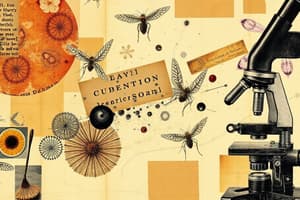Podcast
Questions and Answers
What is one of the most important tools in the biological sciences?
What is one of the most important tools in the biological sciences?
The microscope
A typical compound microscope extends the vision of the observer more than __________ times.
A typical compound microscope extends the vision of the observer more than __________ times.
one hundred
What type of microscope is most commonly used?
What type of microscope is most commonly used?
The light microscope
What do compound microscopes use to magnify specimens?
What do compound microscopes use to magnify specimens?
An example of the compound light microscope is the __________.
An example of the compound light microscope is the __________.
What does the compound dark field microscope do?
What does the compound dark field microscope do?
What type of light does the fluorescence microscope use?
What type of light does the fluorescence microscope use?
What is the primary function of the phase contrast microscope?
What is the primary function of the phase contrast microscope?
What does the norman ski microscope use to study structures?
What does the norman ski microscope use to study structures?
What do electron microscopes use to magnify a specimen?
What do electron microscopes use to magnify a specimen?
What is the transmission electron microscope used for?
What is the transmission electron microscope used for?
What feature does the scanning electron microscope provide?
What feature does the scanning electron microscope provide?
What connects the ocular to the body tube in a compound microscope?
What connects the ocular to the body tube in a compound microscope?
What serves as a handle on a microscope?
What serves as a handle on a microscope?
What is the function of the nosepiece in a microscope?
What is the function of the nosepiece in a microscope?
What do the lower lenses attached to the nosepiece of a microscope called?
What do the lower lenses attached to the nosepiece of a microscope called?
What does the fine adjustment knob do?
What does the fine adjustment knob do?
What is the illuminator's role in a microscope?
What is the illuminator's role in a microscope?
What does the iris diaphragm regulate?
What does the iris diaphragm regulate?
The distance between the objective lens and the specimen is called the __________.
The distance between the objective lens and the specimen is called the __________.
What is the field of view in microscopy?
What is the field of view in microscopy?
How does magnification depend on objectives?
How does magnification depend on objectives?
Most microscopes are __________.
Most microscopes are __________.
Flashcards are hidden until you start studying
Study Notes
Microscopes in Biological Sciences
- Microscopes are essential tools commonly used in biological research.
- A typical compound microscope magnifies objects over one hundred times, while transmission electron microscopes can magnify up to one million times.
Types of Microscopes
- The most common type is the light microscope, featuring a single lens in its simplest form.
- Compound microscopes utilize two lenses for enhanced magnification.
- Bright field microscopes allow light to pass directly through specimens, creating a dark appearance against a light background.
- Dark field microscopes reflect light off specimens, making them appear bright against a dark background.
- Fluorescence microscopes employ UV light and fluorescent dyes to visualize specimens.
- Phase contrast microscopes enhance minute structural differences within specimens using regular light.
- Norman ski microscopes analyze structures by differences in refractive index.
- Electron microscopes use electron beams for magnification; they include transmission electron and scanning electron microscopes for thin sections and three-dimensional views, respectively.
- Scanning transmission electron microscopes combine features of both scanning and transmission microscopies.
Components of Compound Microscopes
- Ocular (eyepiece): The lens through which specimens are viewed.
- Draw tube: Connects the ocular to the body tube.
- Body: Holds the nosepiece and includes the draw tube.
- Arm: Serves as a handle for maneuvering the microscope.
- Nosepiece: Revolves to hold and switch between objectives.
- Objectives: Lenses attached to the nosepiece, coming in various power options:
- Scanning objective: Shortest lens for low magnification.
- Low power objective: Used for initial focusing on specimens.
- High power objective: Provides fine focusing details.
- Oil immersion objective: Utilizes immersion oil for enhanced magnification.
Microscopic Functionality
- Stage: Platform for placing slides.
- Illuminator: Provides light to illuminate samples.
- Iris diaphragm: Regulates light intensity entering the microscope.
- Condenser: Focuses light on the specimen from below the stage.
- Coarse adjustment knob: Used for initial focusing; applicable only with scanning and low power objectives.
- Fine adjustment knob: Refines focus on specimens.
Microscopy Techniques and Considerations
- Many microscopes are parfocal, allowing for focus retention when switching objectives.
- Magnification results from multiplying the power of the ocular and objective lenses.
- Resolving power distinguishes closely placed objects and is influenced by lens design and quality.
- When observing specimens, slide movement is inversely related to image movement.
- Proper illumination is crucial; improper settings can lead to poor imaging and strain on the eyes.
- The working distance, or distance between the lens and specimen, decreases as magnification increases, requiring more light.
- The field of view changes with magnification levels; higher magnification results in a smaller field of view.
- Microscopic lenses have a specific plane of focus, with an associated depth of field that decreases under greater magnification.
- Oil immersion objectives are valuable for examining small organisms and detailed specimen characteristics.
- Wet mounts are prepared slides for viewing fresh specimens under a microscope.
Studying That Suits You
Use AI to generate personalized quizzes and flashcards to suit your learning preferences.




